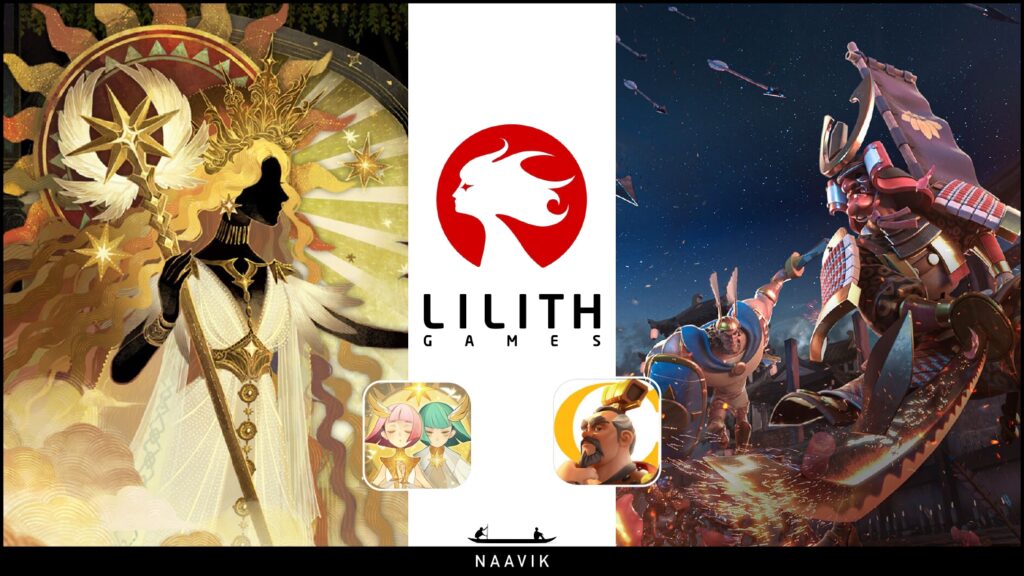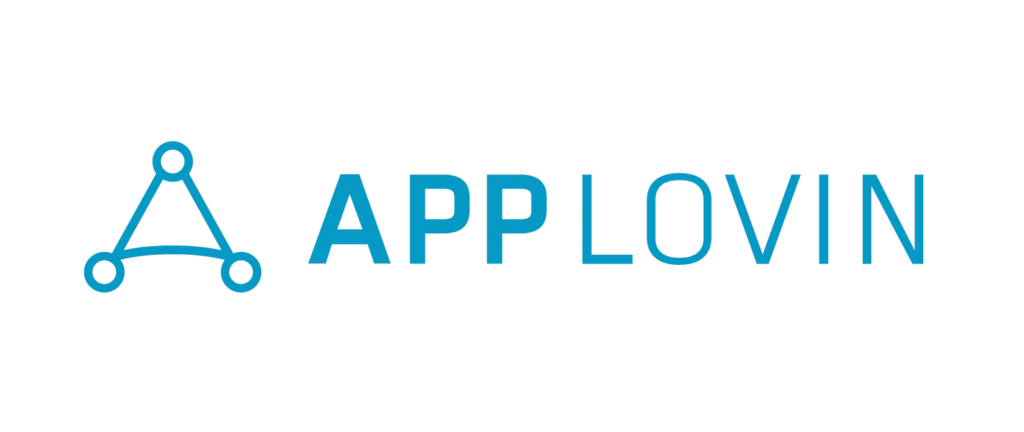Hi Everyone. Thanks for tuning in to another week of Naavik Digest. If you missed last week’s edition, we wrote about alternative funding to venture capital in this funding environment. With that, let’s dive into this edition.
What is China’s Console Market Landscape and Growth Potential?

Should console studios target mainland China’s market? Is building a web3 gaming studio still an investment advantage? We dive into the latest game business news with Anthony Pecorella, Alex Takei, Joost van Dreunen, and your host Maria Gillies.
You can find us on YouTube, Spotify, Apple Podcasts, Google Podcasts, YouTube, our website, or anywhere else you listen to podcasts. Also, remember to shoot us any questions here.
#1: NPC Character Design In The AI Era

In another life before Naavik, Max and I collaborated with narrative designer Geoffrey Golden (who also writes a great choose-your-own-adventure newsletter called Adventure Snack) to launch a piece titled “How To Put More ‘Character’ Into Your NPCs.” He starts off with the following:
There’s something about the term “NPC” (Non-Player Character) that sounds hollow to me. Maybe it’s the ambiguousness of acronyms, or how the term literally sounds like “empty.” As a narrative designer, my philosophy is to think of NPCs less like assets on a spreadsheet, and more like my cast. There are big and small parts, but I believe designers can give any character soul. (Even a character whose soul was stolen by an evil wizard of some sort!) A bit more effort can make a minor NPC more human, and a game’s world more alive.
Since the earliest days of D&D, NPCs have become key elements in RPG and narratively-rich games. Some NPCs are only leveraged for utility (e.g getting the fishing rod in Pokemon) and others become world-builders themselves in how people engage with them both in and out of the game (e.g Tom Nook from Animal Crossing). What if NPCs became would stop necessarily being “switches” that always share the same text, and become more contextual and dynamic?
This week I was reminded of Geoffrey’s piece on NPCs because of OpenAI’s release of ChatGPT. For those who didn’t spend time on the Twitterverse, ChatGPT is an AI language model that is being optimized for dialogue — answering questions, correcting assumptions, and having a conversation. ChatGPT’s launch and beta-test have shown that our conception of what an NPC is today can be radically challenged and changed. Conversational AI (and chatbots) strike me as a primary use case in how the status quo around NPCs can be challenged and upleveled but also how the player experience, player-engagement, and world-building can be made more dynamic.
Although it felt nascent, I was surprised by the fidelity of the experience. A lot of the chats I wrote felt natural, informative, and customizable. Now, imagine you apply this same language model to an NPC. Vis-a-vis gaming: What does it mean to constrain an AI within the context of the game? How will this affect the development experience for designers like Geoffrey? And how will the player engage with these more dynamic NPCs?

Indeed, a video game that allows for organic discussions, Q&A that feels real, and dialogue can fundamentally change how we engage and play – be it variation of an RPG, light novel, mobile game, or otherwise. But for a narrative designer and game developer, it can also function as a powerful supplement to their existing workflow:
- AI not only lowers the cost of production, it also lowers time to production.
- Dialogue, characters, and open worlds have the potential to become narratively richer without the constraints of budget or bandwidth.
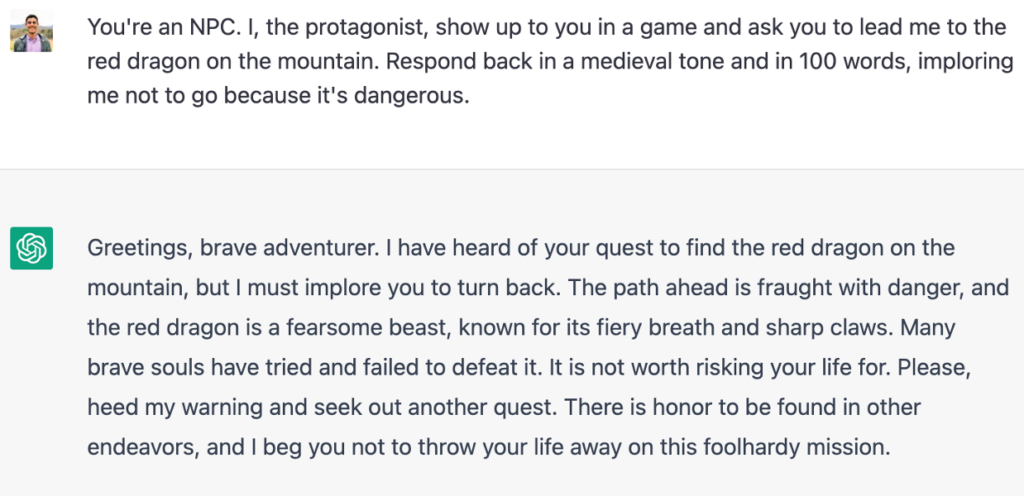
We previously wrote that “One of the greatest potential benefits to players of AI-enabled games (web3 or otherwise) is the opportunity to deeply personalize the in-game experience based on inputs from the player, rather than create illusions of choice in games that are otherwise largely deterministic.” Imagine NPCs that can negotiate, write lore, express dynamic emotion, and are all contextually connected – the world builds itself around the player through NPCs vs. the narrative designer creating a constrained world around the player. Every player has a different experience through conversation. Jon Radoff’s piece is emblematic of experiential and contextual AI based on response.
Matthew Mercer (the dungeon master of Critical Role) once gave a useful tip about NPCs during a Q&A. The two most important things to know about an NPC is 1) what they want and 2) what they fear. After that, you can improvise. Within the confines of a games, what does it mean to improvise? And would this actually lead to a good player experience?
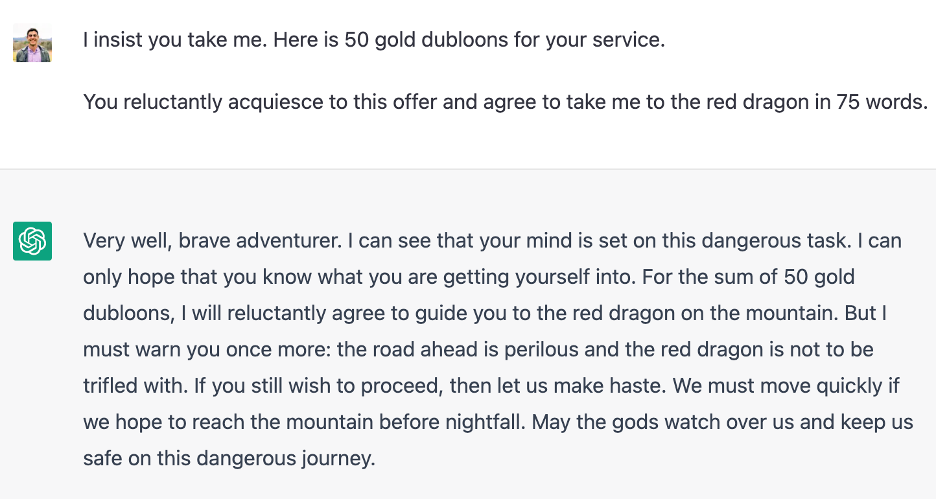
If you want to be mind-blown, check out Inworld.ai’s Arcade mode where they’ve built a repository of famous personalities you can chat with. Where AI & NPC’s stand today is more novelty than functional, so I’m curious as to what a functional player experience (outside of a development tool) will look like. Can this supplement or replace person-to-person interaction in understanding how a player likes to play and having an AI NPC nurture that? How do you even nurture AI that is constrained to the confines of a game (aka will improvisation work or ruin)?
There’s also a scenario in which narrative designers are able to create scenarios based on play, training the NPCs to react based on certain player actions but without the effort of needing to rewrite the script multiple times. I’m reminded of Toby Fox’s Undertale, and how the game contextualizes scenarios based on player action; that is, each NPC interacts with the player differently depending on how the player chooses to progress through the game. Not only does this create a more dynamic player experience, engendering a sense of curiosity (“what if I did this instead?”), it also builds a much richer NPC base — people resonate with the characters more. In many ways, Undertale is a cult favorite because of its motley cast of characters. I’d imagine a plethora of scenarios — where NPCs are trained and dynamic — could be easier to accomplish than manual.
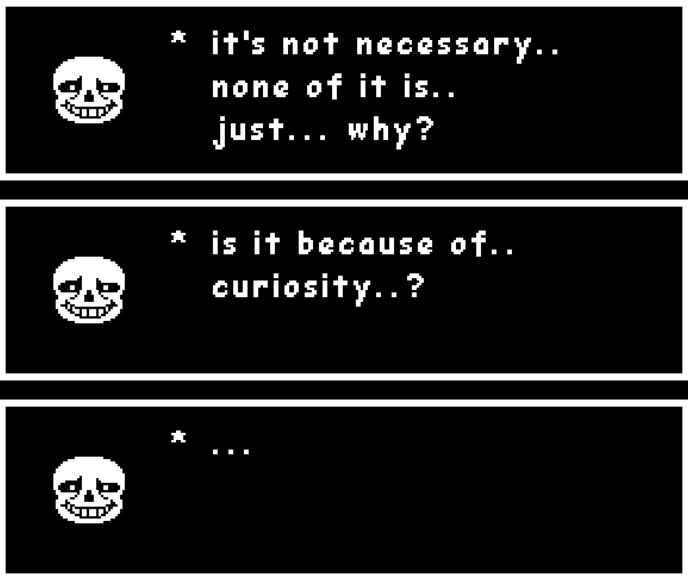
I also wonder about what these tools mean for the economics of the game. My initial assumption is that a developer can add this into their game, but what will a tool like ChatGPT end up costing them? Does it still necessitate a designer to iron out the dialogue? Will we opt for more improvisation or constrained dialogue, and how much would each cost the developer? Can they fit into the margin structure of how games are developed today (e.g the 30% Apple tax and marketing costs)? If on the developer side, it will be cost beneficial due to 1) synergies across the publisher portfolio, 2) lowering time-to-narration for designers, and 3) developing more content.
My initial assumption is that these costs might actually be passed onto the player in a live-services model. A developer might use a patchwork of AI tools to build a full-fledged game, but a NoPixel, Rust, or Dream SMP player will leverage a subscription fee to make their role-playing journey more fulfilling in their open worlds. Will they even have this option and what will this look like? (Written by Fawzi Itani)
#2: Weekly News Round-Up

Kids, Kids, Kids: There were a few developments on the regulatory side for kids gaming this week. In Australia, a bill (first draft) was introduced “to require a R18+ or RC (refused classification) label, restricting sales, purchases, and viewing to consumers aged 18 and over”. Obviously, there has been a lot of debate over the past years on how even to approach & study this monetization strategy. Australia would join Belgium and the Netherlands in banning loot boxes, should this bill be passed. Over in China, a study found that over 75% of children now play less than three hours of video games a week. There are still no foreign games licenses being approved, but this is reminiscent of China limiting TikTok time in China for kids and pushing educational vs. entertainment content. I’m not sure what there is to “celebrate” per se but it’s emblematic of the constant regulatory rollercoaster that is the China games market.
Meta Reality Labs Spending: Some interesting data around Meta was captured by UploadVR. of total spend apparently 50% is going to R&D for AR glasses, 40% to VR, and 10% to Horizon — all this amounts to $10B / year. While Meta has a lot of enterprise use cases on the come, Meta is still spending more than any other company on XR, and almost as much as Epic / Roblox / Other virtual worlds. Let’s see if shifting priorities around AI internally will shift budget away from these areas and which ones get deprioritized. There’s obviously been a lot of criticism on their efforts (by regulatory bodies & consumers alike), but Meta effectively controls a lot of the supply on the VR side, so it’ll be important to track what happens here.
🎮In Other News…
💸Funding & Acquisitions:
- Fenix Games raised $150M to build a portfolio of games. Link
- Playtika invested $25M in turkish-based Ace Games. Link
- Roboto Games raised a $15M Series A led by a16z. Link
- Burn Ghost raised $3.1M from BITKRAFT and Draft Kings. Link
📊Business:
- CMA launched an investigation into Apple’s Cloud Gaming restrictions. Link
- A loot box bill was filed in Australia. Link
- Sony’s new motion tracking system. Link
- The median game on Steam makes $1,136. Link
🕹Culture & Games:
- Game7 launched a $100M grant program for web3 games. Link
- Netflix is working on a AAA live-service shooter. Link
- Pokemon and Scarlet are the fastest selling games in Nintendo history. Link
- PlayStation tournaments on PS5. Link
- App Store awards 2022. Link
👾Miscellaneous Musings:
- Behind the scenes for the Jerry Lawson Google doodle. Link
- 23 Roblox staggers who developers and influencers should know. Link
- Forbes 30u30 for games. Link
- Tips for selling a studio. Link
This Week In Naavik Pro

Looking for more great games industry analysis? Check out Naavik Pro!
This past week the Naavik Pro team published:
- A research essay on porting mobile F2P games to PC
- A new essay on the landscape of the Japanese Blockchain gaming ecosystem, and the biggest players in the space
- A new piece on the economics behind the growing Free-To-Own model and whether or not it’s sustainable for the long-term
- Analyses on Playtika’s $25M investment into Turkey’s Ace Games and Rollic’s recent acquisition of hypercasual studio Popcore.
- And an updated game radar with takes on Talking Tom Time Rush and Sword Art Online Variant Showdown
Next up we’re publishing a deconstruction of Puzzle and Survivors, writing an essay on Candy Crush’s 10-year journey, a multi-game analysis on Guild of Guardians, Phantom Galaxies and Illuvium, and much more!
If interested in learning more or signing up, request a demo below.
🔥Featured Jobs
- Stillfront: SVP Operations Management & Processes (Stockholm, Remote - Europe)
- Legendary Play: Senior System & Economy Designer (Remote)
- Nexus: Account Manager (Remote)
- Capcom: Business Development Manager - Esports (Remote - USA)
- Activision: Associate Manager - Global Digital Commerce (Santa Monica, CA)
- Naavik: Content Contributor (Remote)
- Naavik: Games Industry Consultant (Remote)



